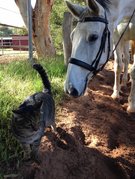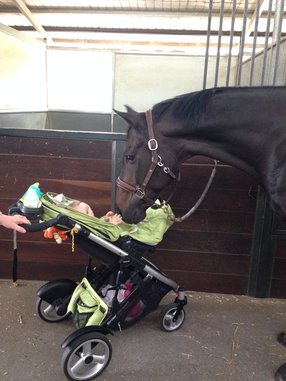
Karen Pryor’s book, Don’t Shoot the Dog heralded the start of the clicker training revolution. Pryor started out as a trainer of dolphins and whales and her work really drew attention to the possibilities of positive reinforcement. Like most trainers who work with wild or aquatic animals, Pryor is understandably cautious about the use of negative reinforcement – this facet of operant conditioning is rarely appropriate in a zoo or aquarium setting because these trainers work at a distance from their charges. For those of us who have physical contact with the animals that we train (horses, camels, elephants and to a certain extent dogs) negative reinforcement isn’t an option, it’s our bread and butter…

It’s useful to point out here that the terms positive and negative when used to describe behavioural change are not value judgements, they are mathematical. That is, positive reinforcement occurs when the animal (or human) is given something they want after a behaviour. This increases the likelihood that the behaviour will occur again. Negative reinforcement occurs when something that the animal (or human) doesn’t like is removed at the onset of a behaviour, thus increasing the likelihood of the behaviour occurring again.
I’ve always felt that Pryor’s scepticism over the use of negative reinforcement was misplaced. When done well negative reinforcement can be extremely elegant and subtle. When a horse is correctly trained only the lightest touch by the rider is required. Also, because the pressure should start extremely light and gradually be increased, negative reinforcement also provides the animal with a degree of predictability – which for the horse is very important for optimal welfare.
Negative reinforcement can also be used to great effect in conjunction with positive reinforcement in a technique that is known as combined reinforcement. When paired, negative reinforcement provides the motivation for behavioural change and positive reinforcement amplifies the reward. Combined reinforcement, when used correctly, increases the speed at which training occurs and can lower the arousal level of the animal being trained. So, for example, when a young horse is being trained to respond to the rider’s signal for stop, pressure is applied to the reins and when the horse stops the pressure is released. After the release the rider can caress and stroke the horse’s neck, thus combining both negative and positive reinforcement.
These omissions aside, Don’t Shoot the Dog is a great book and full of some really useful ideas and techniques. One of the most interesting parts of the book is the section on untraining. Pryor identifies 8 different methods for retraining incorrect behaviour and I think they are worth examine as they can offer a different perspective on curing unwanted behaviours.
I believe that Pryor misses two really vital untraining methods and these are:
I’ve always felt that Pryor’s scepticism over the use of negative reinforcement was misplaced. When done well negative reinforcement can be extremely elegant and subtle. When a horse is correctly trained only the lightest touch by the rider is required. Also, because the pressure should start extremely light and gradually be increased, negative reinforcement also provides the animal with a degree of predictability – which for the horse is very important for optimal welfare.
Negative reinforcement can also be used to great effect in conjunction with positive reinforcement in a technique that is known as combined reinforcement. When paired, negative reinforcement provides the motivation for behavioural change and positive reinforcement amplifies the reward. Combined reinforcement, when used correctly, increases the speed at which training occurs and can lower the arousal level of the animal being trained. So, for example, when a young horse is being trained to respond to the rider’s signal for stop, pressure is applied to the reins and when the horse stops the pressure is released. After the release the rider can caress and stroke the horse’s neck, thus combining both negative and positive reinforcement.
These omissions aside, Don’t Shoot the Dog is a great book and full of some really useful ideas and techniques. One of the most interesting parts of the book is the section on untraining. Pryor identifies 8 different methods for retraining incorrect behaviour and I think they are worth examine as they can offer a different perspective on curing unwanted behaviours.
- Shoot the dog. That is, remove the problem completely. So, if your dog bites – euthanize it. If your horse bucks you off – sell it. This can be the most effective way of getting rid of unwelcome behaviours and in the case of dangerous ones – like savage dogs, might be the only safe option.
- Punishment. If the dog bites, hit it. Smack your child for drawing on the walls, yell at your spouse for leaving his towel on the floor. Punishment is the ‘go to’ option for many people and the solution that is often seen as the most effective. It’s important to remember though that punishment can be reinforcing for the punisher, which is often a slippery slope to welfare violations. Behaviourists agree that punishment should be avoided as much as possible.
- Negative reinforcement. Apply pressure to the lead until the dog slows down, refuse to speak to a friend until they are polite, use leg signals to motivate the horse to enter the water jump. For horse trainers negative reinforcement is a big ticket item – we are bound to the use of negative reinforcement, so it is important that we understand exactly how it functions.
- Extinction. If a behaviour is not reinforced its frequency declines and eventually it disappears – this is known as extinction. For horse trainers it is worth noting that anything that involves the flight response is not subject to extinction. In fact, flight response behaviours just get better the more they are practiced, regardless of whether they are reinforced or not. For behaviours that don’t involve the flight response this method can be really useful. Ignore the kids when they’re noisy in the car, fail to react to a spouse’s rudeness, ignore the begging dog. Eventually, these behaviours may be subject to extinction and you won’t have lifted a finger!
- Train an incompatible behaviour. This is possibly one of the most interesting and elegant solutions to unwanted behaviours. If the dog begs – train him to sit on a mat at dinner time. If the kids are noisy in the car, train them to sing and clap along to music. If your horse raises his head during bridling, teach him to lower it on cue.
- Put the behaviour on cue. This is definitely one you wouldn’t use for dangerous behaviours like rearing or biting! However, Pryor suggests it can be useful for behaviours like barking in dogs, so if your dog barks, teach him to “speak”. The philosophy behind this idea is that behaviours that are on a cue tend to diminish in the absence of that cue. I think it has a certain merit in some circumstances but rather than just putting the behaviour on cue I believe it is far more effective to put both the start and the finish of the behaviour on cue. So, if your dog barks – don’t just teach him to bark, but teach him to bark until you give the cue for him to stop barking. That way, if he barks when you don’t want him to, you can give the cue for stop barking and then reward him for stopping barking. This is where training often goes awry… people tend to use cues that they haven’t trained in order to get rid of behaviours that they don’t want. It’s very common to see horses pawing (it is a behaviour that is caused by a conflicted desire to move forwards and the inability to do so). People often punish a horse for pawing but it generally just causes more conflict which leads to more pawing.
- Shape the absence of the behaviour. So, reinforce everything that isn’t the incorrect behaviour. It’s a hard one to implement in horse training but useful in human interactions. So, if your dog barks at night wait until he is quiet and then reinforce him. If your employees are lazy, reward them well for any jobs that they do well.
- Change the motivation. This is the most holistic method of training and one that we utilise regularly. Horses most often display incorrect behaviours because of a gap in or a problem with the way their basic responses (stop, go and turn) have been trained. If you clarify the training and make their responses light and reliable they will offer the incorrect behaviour far less often. Utilising this approach also means you need to look at your horse’s overall management in order to ensure he is able to fulfil as much of his ethogram (the blueprint for natural behaviours that the horse is born with) as possible. So, he needs the companionship of other horses. Preferably he should have physical contact with other horses and if this is not possible he needs to have that deficit rectified with lots of physical contact from a human. He also needs plenty of space to move and low value roughage to eat. If you sort out his environment and his basic responses, his problem behaviours will almost certainly reduce, if not disappear.
I believe that Pryor misses two really vital untraining methods and these are:
- Prevent the expression of the behaviour. It’s not as drastic as shooting the dog but it can be useful during the retraining process to prevent the animal from performing the behaviour. So, for example, if a horse bolts in open spaces it is very useful to ride it in small, enclosed areas while retraining the basic responses. If you are training a dog not to beg it is useful to confine it during most meal times so that it doesn’t practice begging – and then train it when you have time and the energy for training, rather than just yelling at it to stop begging when you aren’t in the mood for training.
- Desensitisation. The root of a lot of incorrect behaviours lies in fear. Fear of strangers in dogs, fear of clippers, floats, plastic bags, rugs, cars, bicycle, umbrellas, needles etc etc etc in horses. It makes sense that part of any untraining program will involve a complimentary desensitisation program. There are six main ways to desensitise and we’ll look at all of these in more detail in our next blo

 RSS Feed
RSS Feed
